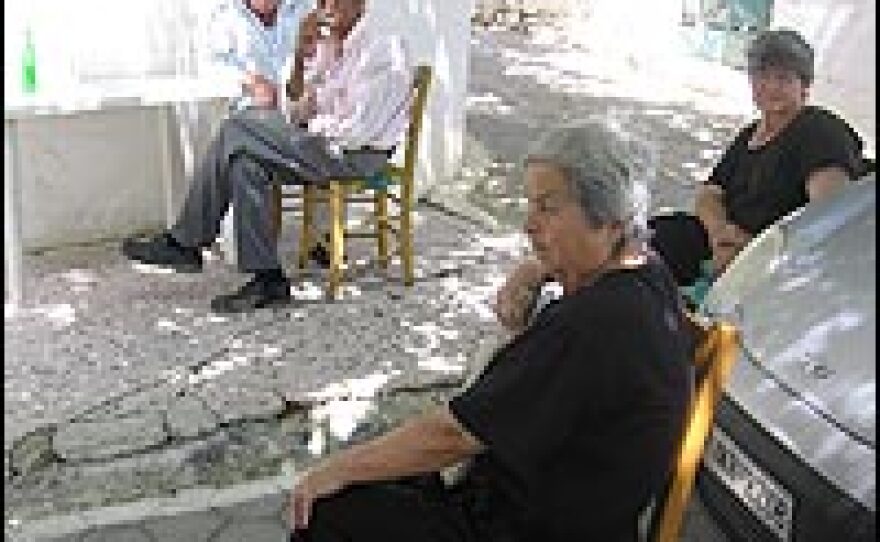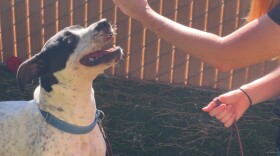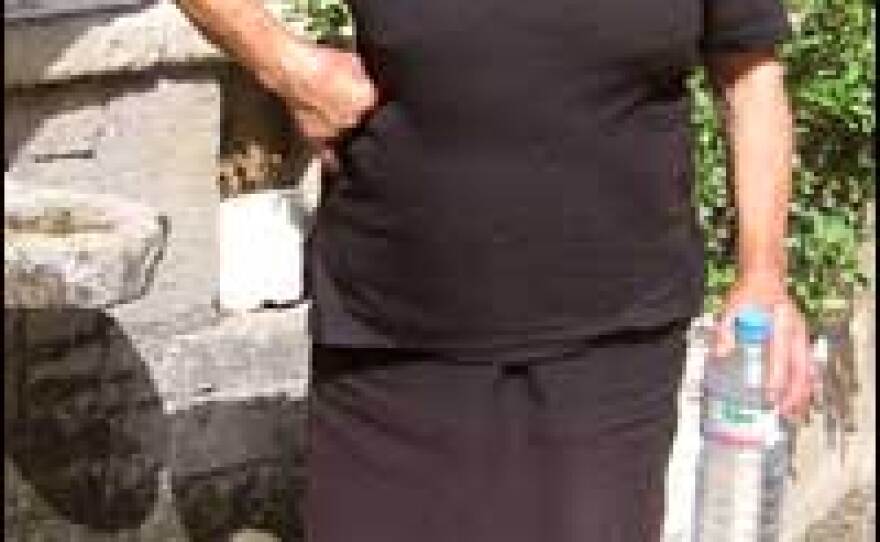
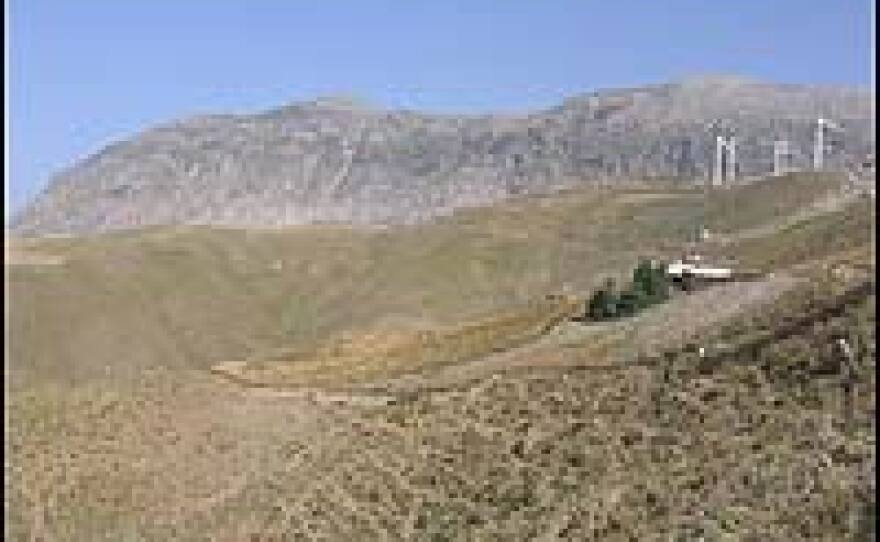
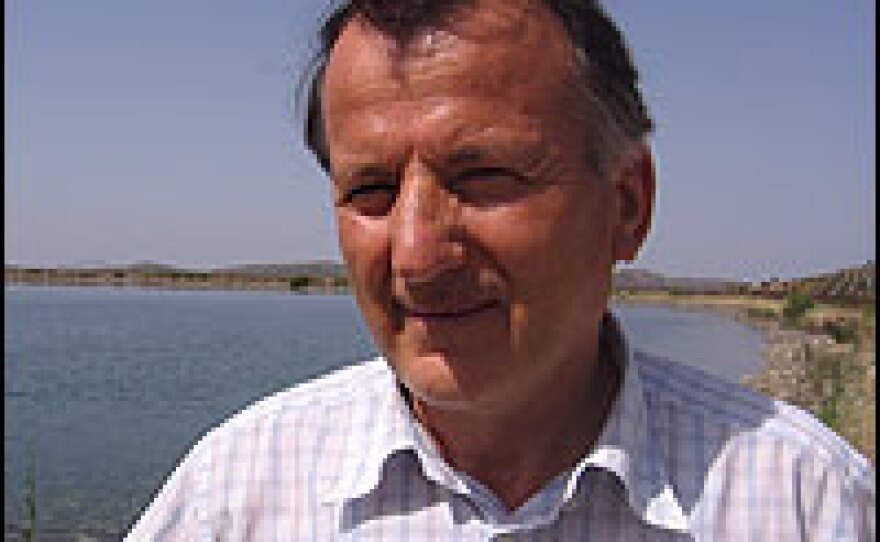
This summer brought a heat wave that people on the Greek island of Crete won't forget. On the front-page of the newspaper, there's a one-word headline in huge type: CHAOS. People are getting a first-hand lesson in how just a slight change in weather patterns because of climate change can bring big problems.
Scorching temperatures have caused wildfires, electricity blackouts — and even deaths. Farmland is drying up, and people are struggling to find the water they need to irrigate their fields and olive groves and even to drink.
In the town of Agia Varvara, Costas Kaliokannakis is the local official busily trying to fix the problems caused by the heat. It's mid-morning, and his office is dark and steamy. Drops of sweat leave a trail across his forehead.
"We've had it for the last four days," Kaliokannakis says. "And it's been over 40 degrees Celsius. In some areas around here, it actually reached 47 degrees."
That is 116 degrees Fahrenheit.
Kaliokannakis says all the wells have dried up; the heat comes after a winter when there was little rainfall. "I remember this area from my childhood years," he says. "And I have never seen it this way. This is the first time I've seen that we've completely run out of water."
Especially At Risk
This large island is located about halfway between the Greek mainland and North Africa. Its geography puts it at particular risk from even the smallest shift in weather patterns.
At a grassy flat at the bottom of a mountain range, two water reservoirs sit side by side. Dragonflies dart about and ripple the still water.
The big reservoir is just several years old. The small one is thought to date back more than 3,000 years, built by the Minoans, Europe's first great civilization.
Professor Costas Kosmas explains that the ancient reservoir and the newer one are doing exactly the same thing, storing water because they don't have enough water in the region. "The technology is almost the same as it was 3,000 years ago," he says.
Kosmas teaches soil science at the University of Athens, and he represents Greece on various international committees on climate change. He says this year's sultry summer has made people think even more about the problems caused by heat and drought. He wants them to think, too, about the way people make the problems worse.
Tourism is vital to Crete's economic future. But it takes a lot of water to run the hotels, restaurants and water parks that cater to the tourists — and to keep the parched greens on the golf course from turning brown. Kosmas says the island's precious water should go to farms and homes, not to golf courses.
A Climate Chain Reaction
Kosmas drives up a rutted mountain road, looking at how trees and vegetation are disappearing in the high range near Mount Psiloritis. In Greek mythology, Zeus was born in a cave close nearby and kept hidden from his father, who wanted to kill him. The mountain slope looks like a gray moonscape.
"When the land is degraded and desertified, this affects the climate, affects the economy, affects the environment," Kosmas explains.
The land dries up slowly. Desertification starts small: temperatures rise a bit, rainfall decreases a little. There's less water in rivers, wells and the ground. Farmers can't grow crops. They abandon the land to their sheep and goats.
The land just below the mountains is brown and barren. Sheep eat the shoots of young trees and vegetation before the greenery can grow.
In the past decade, the European Union supported agriculture by giving subsidies to sheep farmers. The more sheep you had, the more money you got. Kosmas says that now must stop.
"European Union now is going to the direction to combine agricultural policy with environmental policy," he says.
At the urging of Kosmas and others, the EU will start paying farmers to reduce the number of animals they own.
Kosmas says half the land in Crete is at high risk of desertification. A recent United Nations report says the problem isn't just on this Mediterranean island or in sub-Saharan Africa. It now threatens one-third of the world's population.
Back to the Well
Back in the town of Agia Varvara, residents have gone three days with no or little water. A sound truck moves slowly through the town, telling residents, "Turn off your electricity," because work crews need the power to get the water pumps working again.
On a busy street corner, Antigone Skoula goes to one place where people can still get water — at the village well. She is an elderly woman, dressed in black, with a black scarf covering her white hair.
"They're cutting it off," she says, "but we do have some water, yes. Every two days or three days, we have water."
The old woman fills seven plastic bottles and carefully puts each one back in the burlap bag she carries. Then she trudges up the hill, on her way home.
Drawing water from a well is an ancient practice. In Crete's hot summer, it has become a necessity again.
Copyright 2022 NPR. To see more, visit https://www.npr.org. 9(MDAzMjM2NDYzMDEyMzc1Njk5NjAxNzY3OQ001))


